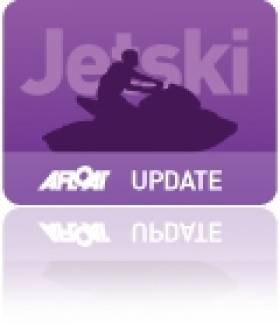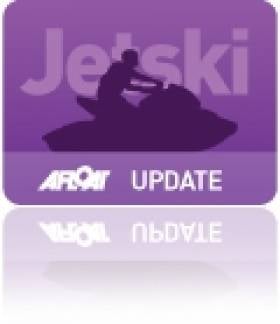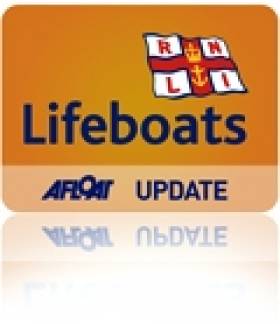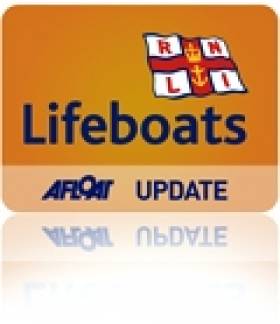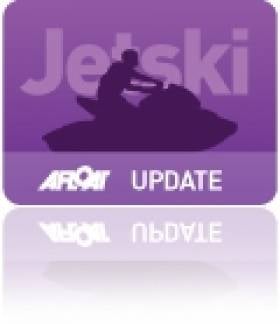Displaying items by tag: Jetski
Legislation & Guidance on the Use of Personal Water Craft (Jet Skis) from Waterways Ireland
Waterways Ireland has issued a notice to provide advice to operators of Personal Water Craft (Jetskis) in order to ensure the safe enjoyment of the inland waterways for all.
Personal Watercraft (PWC) are largely enjoyed responsibly, yet they present a risk to other water users, protected wildlife and can be a source of nuisance. This note provides legislative guidance for enforcement officers.
Definition
PWCs, often referred to as jet-skis, are rapidly increasing in popularity. PWC is a watercraft that is less than 4.88 metres, propelled by a two or four-stroke petrol engine that powers a water jet pump. Capable of speeds exceeding 100 km/hr and are highly manoeuvrable.
- Associated Hazards. Recent experience has identified:
- Fatal or near-fatal accidents involving collisions with swimmers.
- High incidence of accidents with PWCs and collision with other craft.
- Breach of local speed limits.
- Associated anti-social activity; noise, nuisance/aggressive driving and disregard for other water users.
- Disturbance of protected wild-life.
Legislation
PWCs are subject to Local Authority Bye-Laws[3] and the Maritime Safety Act 2005[4] the majority of which require users of PWCs to:
- Be familiar with relevant bye-laws in force in the waters they use, as bye-laws differ, and many inland lakes prohibit PWCs e.g. Corrib and Mask.
- Have a permit granted by the Council or Waterways Ireland, that can be produced when requested by an authorised officer or member of An Garda Síochána.
- Comply with local water speed limits. Specifically, 5 knots when entering and exiting launch areas or areas with designated speed limits.
- Exceptional care and attention in the vicinity of bathers, no more than 5 knots.
- Irrespective of local speed limits; no PWC should be navigated at such speed or in such manner as to cause or be likely to cause nuisance, injury or damage to persons or property or to other vessels or boats.
- Wear Personal Flotation Device / Lifejacket at all times, including when being towed.
- Act in such a manner as not to cause annoyance to any person using a beach or swimming in the sea or to disturb naturally occurring flora and fauna.
- On coastal areas, the use of PWCs within 300 metres of the foreshore is prohibited except at the designated launch areas.
- No person shall bring a jet-ski or fast powerboat into a Designated Bathing Area.
- Persons under the age of 16 years should not operate a PWC (SI 921 of 2005).
- PWCs must be launched and recovered from designated sites.
- Penalties vary depending on Local Authority Bye-Laws.
Exempt from bye-laws are craft operated in the course of duty of the Council, An Garda Síochána, the Defence Forces, Revenue Commissioners, Central Fisheries Board or a Regional Fisheries Board, Irish Coast Guard, Commissioners of Irish Lights and Royal National Lifeboat Institute, Community Rescue Boats or any craft involved in bona fide law enforcement, emergency or rescue missions.
Waterways Ireland thanks waterways users for their co-operation in relation to this matter.
A recent spate of Jet Ski (Personal Watercraft) infringements into swimming areas, resulting in a greater risk to members of the public and increased demands on Search and Rescue organisations, has prompted organisations to issue a joint appeal to jet ski users. Personal watercrafts are an enjoyable form of water-based activity. Users must, however, in addition to their own safety, respect the safety and wellbeing of other water users and remain vigilant at all times to any unnecessary encroachment into other activities, particularly swimming areas.
During the months of April & May, the Coast Guard coordinated responses to 18 Jet Ski related incidents, 12 of which related to complaints pertaining to encroachments into swimming areas.
Coast Guard’s Operations Manager Micheál O’Toole said: ‘We would like to thank all members of the public for their continued safety efforts on or near the water as we approach what is expected to be another busy June bank holiday weekend. Please at all times take time to plan your activity, ensure that it is safe to do so and ensure that somebody ashore is either monitoring your activity or knows what time to expect you back”
The public are requested to familiarise themselves with the following key safety measures before using a PWC / Jet Ski.
Do
- Keep a safe distance from other water users
- Learn how to operate your machine
- Know your own and your machine’s capabilities/limitations
- Wear an approved lifejacket or buoyancy aid
- Always use a kill chord
- Check weather forecasts and tides
- Have a suitable means of attracting attention in an emergency
- Advise someone ashore of your expected departure and return times
Don’t
- Operate your machine in the vicinity of other water users e.g. swimmers, divers, craft such as angling boats, canoes, sailing boats etc.
- Cause a safety hazard by high-speed use
- Create unnecessary noise and disturbance to other people or wildlife
- Allow those under 16yrs of age to operate PWCs or other Fast Powered Craft
- Drink and Drive
Water Safety Ireland has expressed concern about a proposal to ban the use of jetskis from a number of popular beaches on the Clare coastline.
As The Times Ireland edition reports today, Clare County Council proposes prohibiting the launching of all personal watercraft – as in jetskis – along with fast power craft, and power craft from Lahinch beach.
The draft bylaws also cover well-known west coast beaches at Miltown Malbay, Spanish Point, Doonbeg, Ballycuggeran (Killaloe) and Ballyallia lake near Ennis.
Additionally, the use of inflatable toys on all beaches in Clare may be banned under the proposed legislation, given the risks posed by their use and the number of incidents involving young children.
Water Safety Ireland (WSI) chief executive John Leech told the newspaper that jet skis or personal watercraft have proved invaluable in coastal rescue – particularly off the busy Clare coastline.
WSI believes zoning beaches for water users is preferable to an outright ban, he says.
The Irish Tow Surf Rescue Club has also objected to a jetski ban, while several of its members have registered personal opposition with Clare County Council.
The club has over ten jetskis equipped as rescue craft and has over 80 members. It has provided safety support to maritime events, including triathlons and open water swimming events off the west coast.
The club’s chair, Peter Conroy, who is a fireman, trained lifeguard and award-winning surfer, has worked with the emergency services for the past 17 years.
Conroy said that no personal watercraft owners in the Whitestrand or Spanish Point areas were consulted about the bylaws.
Conroy and others initiated the club in 2006 after an incident where he was surfing beneath the Cliffs of Moher in Clare and was trapped. He had to swim through 20-foot waves as jetskis used for towing surfers were unable to reach him.
He and his colleagues realised they should be able to train to rescue themselves.
Training has been conducted with the Irish Coast Guard, and the club also works with local swim groups in safety and in supplying the local community with life-saving equipment, including defibrillators, he said.
The British government is considering national legislation to classify jetskis as vessels – requiring their legislation and subjecting them to maritime laws covering all craft.
Clare County Council said its draft 2021 beach bye-laws are “ not scheduled to go before the members (councillors) for adoption until May at the earliest”, and it said it would be “ premature at this time to comment”.
Read more in The Times Ireland edition here
#Hoverboard - Marty McFly's hoverboard in Back to the Future Part 2 may still be a few years off yet - but a new aquatic take on the concept is right around the corner, as Mail Online reports.
Designed by French champion Jetski rider Franky Zapata, the Hoverboard by ZR allows the rider to leap up to five metres above the water thanks to the spring action of its powerful water jet, fed by a length of hose connected to a personal water craft or speedboat.
Zapata's creation will be available to buy later this summer - but researchers in Japan are already hot on its heels with their concept for a overboard that can levitate using soundwaves.
Mail Online has more on the story HERE.
Jet Ski Driver - Are You in Control?
Jetski – The UK Coastguard and North Wales Police are reminding people of the dangers of jet skis and personal watercraft (PWC) ahead of what is hoped will be a busy summer in North Wales.
Last summer Holyhead Coastguard dealt with almost 35 incidents involving PWCs. These ranged from mechanical issues, running out of fuel or even concern that PWCs were too close to shore or endangering swimmers.
In one incident a man and a woman suffered serious injuries after two jet skis collided near Porthmadog and over the same weekend a youngster in Abersoch sustained minor injuries after the kayak he was in was struck by a jet ski.
Ray Carson, Rescue Coordination Centre Manager at Holyhead Coastguard, said:
"The majority of PWC users are responsible and often assist us during search and rescue incidents. However, during the summer months we do receive complaints that jet skis and PWCs have gone too fast and too close to shore. This is concerning to us as it's putting swimmers and other beach-goers in danger. You should check if any bylaws are in place, stick to them and be respectful of others in the water.
"You also need to make sure you know how to operate these powerful machines. The last thing you want is to find yourself in the water after being thrown off. This is why we always recommend that you get yourself trained, wear a buoyancy aid and ensure you're using a kill cord, so if you end up in the water, the engine will stop. Remember, if you see anyone in difficulty at the coast, call 999 and ask for the Coastguard."
Dewi Jones, the newly appointed Police Inspector for South Gwynedd, added:
"Incidents involving inappropriate, unsupervised or careless use of sometimes powerful marine craft impact upon all the emergency services when our resources may be required elsewhere. Last summer at least three people sustained significant injuries. Two of those could have been a lot worse. Working with HM Coastguard, RNLI and other emergency services we'd ask that all marine craft users to adhere to safety advice, act responsibly and consider others in the water so everyone can enjoy the pleasures of our beautiful beaches and seas."
Jet Skiers Spark Portush RNLI Call Out
#rnli – Portrush RNLI volunteer All Weather Lifeboat Crew got their first service of 2014 today, after receiving reports of two jet skiers in difficulties at Benone Beach near Magillian.
The RNLI were alerted by a friend of the two men who noticed that one of the men had fallen off the jet ski into the water.
The weather was blustery and chilly and the sea was very choppy and extremely cold. The All-weather crew quickly located the two men who by this stage were very cold, as they had both been in the water for some time and neither were wearing wetsuits.
The crew got the two young men on board and returned to base were they handed the casualties over to a waiting ambulance.
The crew then returned to the area to recover the jet ski as this could have posed a hazard to other boats and vessels in that area if not recovered. This too was quickly located and a decision was made by the Coxswain to tow the jet ski to the safety of Portstewart Harbour as the surf conditions were not ideal for the Y boat (from the All Weather boat) to tow to the beach.
The crew then returned to station after a four-hour operation
Lifeboat Operations Manager Robin Cardwell commented:
'As this is the start of the summer season we are looking forward to welcoming people to enjoy the North Coast, but we would advise everyone to check their safety equipment after the winter months to make sure it is still in good condition. The Lifeguards will be back on the beaches from 18th April so talk to them before you go out. You can also talk to our crew at the station who can advise of impending weather conditions and the currents and rip tides in the area.
The crew returned to base, refuelled ready for the next shout
Registration For Personal Watercraft Coming In New Year
#Jetskiing - Registration for Jetskis, or personal watercraft, is on the cards in an effort to cut down on antisocial behaviour by 'boy racer' elements that marred some water users' enjoyment of this summer's exceptional warm and sunny days.
According to The Sunday Times of 22 December, the Department of Transport, Tourism and Sport will require owners of such craft, as well as larger vessels like motorboats, to register their vehicles for the first time - a move that's been welcomed by Irish Water Safety.
"There are occasions where these vessels are used in a dangerous, reckless or inconsiderate manner," said the department. "When that does happen it's important to be able to identify the perpetrator."
Though new legislation will be required to introduce registration - which will come with a "reasonable fee" for each vessel - it's believed misbehaving watercraft users would be prosecuted under existing bylaws or health and safety law.
Stranraer RNLI Rescues North Channel Drifters
#RNLI - Stranraer RNLI's lifeboat was dispatched by Belfast Coastguard on Friday evening (7 June) to rescue men from a stranded personal water craft on the rocks at Corsewall Point.
The men had been travelling on the water scooter across the North Channel from Ballycastle in Northern Ireland to Campbeltown in Scotland and back - a round trip of some 130km - but ran out of fuel on the return leg, and drifted to Corsewall on the north point of the Rhins of Galloway.
The RNLI Stranraer lifeboat launched at 5.20pm from Lady Bay and 20 minutes later arrived on scene, where they discovered that two of the men were cold and one had an ankle injury - although a conflicting report via the Belfast Coastguard says only two men were found.
The men were transferred safely on to the lifeboat and taken to Dally Bay, from where they were taken by road to Stranraer Accident and Emergency Hospital.
But as BBC News reports, they were beset by further problems on their return trip to Northern Ireland later that evening, when the private vessel on which they were travelling also ran out of fuel and had to be towed to Red Bay in Co Antrim.
Belfast Coastguard confirmed to the BBC that the men had been travelling on their water scooter with "no navigational aids" and that "they could not get a signal from their mobile phone".
Ideas for Jetski Use Launched on New 'Ride the Wave Right' Website
#JETSKI – The International Council of Marine Industry Associations (ICOMIA) has launched its new global personal watercraft resource website which is intended for PWC riders.
Working in collaboration with personal watercraft manufacturers Kawasaki, Yamaha and BRP, ICOMIA's 'Ride the Wave Right' website, which is available in English, French and German, provides advice for safe and responsible PWC riding, information on the history and evolution of PWC, as well as ideas for recreational PWC activities and tips on how to be environmentally friendly on the water. The website ensures that PWC enthusiasts and government authorities have access to policy and legislation information on CE Products, (the markings and documentation which EU directives require products to carry before being placed on the market), the CIN Checker Database (on-line Craft Identification Number (CIN) checking system) and Grey Imports (PWCs that are not purchased through official dealers in your home country). The website also features links to product and manufacturer information directly from the Kawasaki, Yamaha and BRP websites.
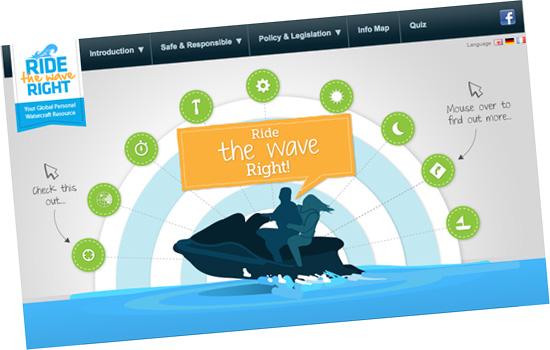
In addition, an interactive world map provides essential riding information such as national regulations, age limits, driving licenses and registration requirements for 27 countries across the globe.
'Ride the Wave Right' also offers the quiz 'Sink or Swim', an enjoyable way to learn about safety issues and to test your personal watercraft knowledge. Should you achieve 100% on the quiz, you get the chance to post your results on Facebook and invite friends to test their riding skills as well. The quiz is also featured on Facebook as a separate "app".
Hans Sipkema, leader of the ICOMIA Marine Engine Committee's PWC Task Force, and Kawasaki Motors Europe, stated that "the website provides a platform for the industry to promote this great sport, and the PWCs ever growing usefulness to society, as more police, fire fighters and life guards discover the great potential these crafts can offer in saving peoples' lives".
It was in the early 1990s that the personal watercraft became the fastest growing category in the recreational boating market and the PWC industry was for a time the fastest growing segment of the marine business. Today PWCs are 75% quieter and up to 90% environmentally cleaner. They can accommodate up to three people, feature environmentally friendly engine technology and increased safety precautions.
Kihira Kosuke, ICOMIA Marine Engine Committee's PWC Task Force member and Yamaha's Product Planner, commented that by providing these resources and advice, PWC users can maximize their enjoyment whilst using the machines safely and responsibly.
Tony Rice, ICOMIA's Secretary General states that "this is a unique resource providing global information and advice for PWC riders and I am grateful to the ICOMIA Marine Engine Committee's PWC manufacturers for their initiative"
For more information, please visit the website at www.ridethewaveright.com
Permanent Jet Ski Berths Launched in Poole Marina
#JETSKI–A new marina in Poole has launched a specialist area for jet skis.
The Port of Poole Marina in Dorest, which enjoys views of Brownsea Island and is close to the historic Poole Quay, is offering 13 permanent berths for jet skis.
John Binder, marina manager, said: "The hassle of storing a jet ski at home, towing it by car, paying to launch it at Baiter Park and having to head home to shower afterwards can detract from the fun of a day on the water. Our new facility offers jet ski owners a place to store their craft, with immediate access to the open sea and a chance to shower and enjoy the local social scene afterwards."
Among those to use the site to store his jet skis is Arran Scott, Principal of Absolute Aqua watersports academy. He said: "The new marina is perfect for us. Until now we've had to store boats further away and our lessons started with a frustratingly slow trip to open sea through areas with a restricted speed limit. Now we're right by the open sea, there's no wasted time, we can park on site and the facilities are excellent."
The marina, which opened this year, was constructed by Walcon Marine (the company behind the marina at the Dubai International Boat Show). It occupies the former Ro-Ro1 Brittany Ferries berth and offers on site toilets, showers and parking and a free water taxi service to nearby Poole Quay.
As well as berths for ribs and jet skis, it houses 59 boats between 10 and 15 metres in length and has visitor berthing for up to six deep-draught super yachts.


























